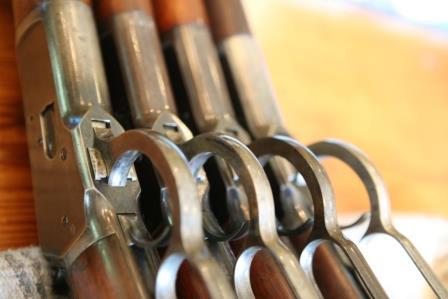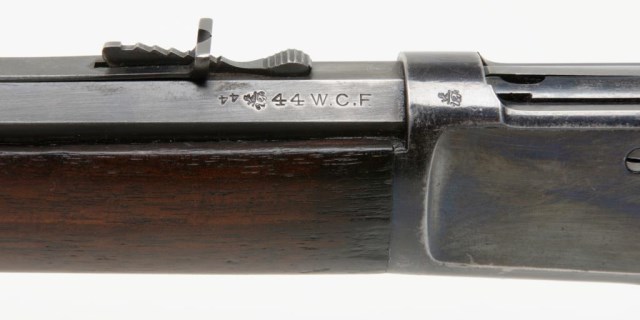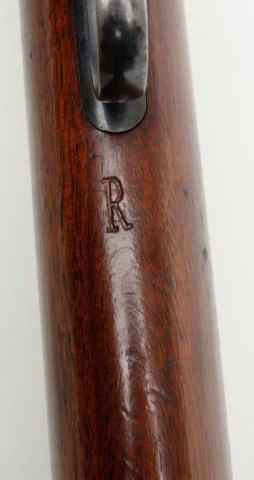July 19, 2013
 Offline
OfflineI have a 1892 Short Rifle , 44-40, mfg. 1913, with the London House Great Britain barrel proof.
The stock has a bold R on the top of it.
This period ( 1913, 1914, 1915 ) is when Britain, France and Imperial Russia purchased Winchesters “ off the shelf “ in models 1886, 1892, 1886 and 1894.
This data is from the current American Rifleman magazine, June, 2015.
It has caused me to research the R on the stock as possibly being a military unit mark.
Any idea what direction or source I could go to to possibly identify the mark or better yet, the military unit ?
Bill
March 19, 2014
 Offline
OfflineThere were Winchester lever rifles purchased by Great Britain in the early months of WW1 but they will be marked with British military proofs like the British broad arrow mark or DCP crossed pennants in the case of Canadian inspected model 1892 and 1894 rifles purchased by the Royal Navy. Your markings look like British commercial proofs which had to be applied to all firearms imported into Great Britain for civilian use.I think there were proofhouses in London and Birmingham, not sure if there were any others.
July 19, 2013
 Offline
OfflineThanks Mike.
Rob Kassab and a friend provided some additional information as follows:
” A wealthy British Member of Parliament ordered 1,000 Model 1892 RIFLES for local militias in his West Yorkshire area, and after the War Office took over responsibility for the Locally Raised Battalions, the Winchesters were transferred to the Royal Navy. Markings unknown.
The fellow was Lord Bunburnholme, actual name Charles Henry Wilson…..
Perhaps his ( my ) gun was used in the Home Guard, a private organization, a railroad, a bank, or in an overseas colony.
The best information on these guns is found in: Edwards, A.O. (Tony), British Secondary Small Arms 1914–1919: Part 3, Land Service Small Arms, Canterbury, Kent, England: Solo Publications, 2008, Spiral Bound, 101 pp “
I am trying to run down a copy of the above referenced book, but not successfully.
I found it amusing that Great Britain didn’t trust Winchester to inspect the 20,000 1892 carbines in 1914 that they did order, and sent down Canadian inspectors to do the task.
Bill
March 19, 2014
 Offline
OfflineI would be surprised if your rifle was part of a government or corporate purchase as it is a short rifle. Being a special order rifle it was likely ordered by some well to do individual then carried abroad. Many turn up that have spent time in India or Africa. The Canadian military inspectors who stamped the 1914/1915 Royal Navy rifles was no indication of mistrust in Winchester. All rifles purchased by the British military were subject to a hands on inspection and owing to distance and the fact that WW1 had just broken out they had to get the “poor colonials” to inspect them. I have read some British military reports that they didn’t stand up well to military use, a lot of broken and damaged parts particularly stocks. I suppose crashing the butt on the deck during drill didn’t help much.
One was used to engage a German submarine on the surface and is probably the only instance of a Winchester being fired at an enemy submarine in history.
March 20, 2009
 Offline
OfflineHello Bill,
There were standard sporting rifles in 44WCF but they all had round barrels, which were purchased and used by the British during WW I. These are marked with CB and then a number on the stock. I have come across at least ten of these in my survey of the Model 1892’s. There is a guy in Australia who is researching both the SRC rifles and these and I have emailed with him several times. Right now I am in St Kitts drinking beer on the beach so am away from most of my research material.
Have I entered your rifle into my survey yet? May I?
Michael

Model 1892 / Model 61 Collector, Research, Valuation
April 15, 2005
 Offline
OfflineBrian,
What is the source of the document you posted a copy of?
I have serious reservations as to its accuracy. Specifically, the alleged 4,500 7 MM single shot rifles supplied by Winchester in 1915. The only “single shot” rifle manufactured by Winchester at that time capable of handling the 7 MM cartridge was the Model 1885, and Winchester most definitely did not manufacture more than just a few rifles in 7 MM. The few that were made, were in 1906.
Bert
WACA Historian & Board of Director Member #6571L

September 9, 2011
 Offline
OfflineBert H. said
Brian,
What is the source of the document you posted a copy of?
I have serious reservations as to its accuracy. Specifically, the alleged 4,500 7 MM single shot rifles supplied by Winchester in 1915. The only “single shot” rifle manufactured by Winchester at that time capable of handling the 7 MM cartridge was the Model 1885, and Winchester most definitely did not manufacture more than just a few rifles in 7 MM. The few that were made, were in 1906.
Bert
Bert,
I don’t think this entry about the 7mm single shot rifles suggests that they were made by Winchester. Were there not other manufacturers of single shot rifles in 7mm that were available at that time?
March 19, 2014
 Offline
OfflineI think they were Remington rolling blocks. One other entry is kinda weird regarding the 9mm Mauser rifles that were supposed to be put on Chilean and Brazilian ships being built in the UK. I think it is a typo as both Brazil and Chile used mausers chambered in 7×57 at the time. Mauser never chambered a military rifle in 9mm to my knowledge.
April 15, 2005
 Offline
OfflineHmmm… I think that I may have misinterpreted what that document was saying. I had Winchester on my mind, and I mistakenly assumed that was what was being referred to. I believe that Mike Webb is correct about them being Remington Rolling Blocks.
Bert
WACA Historian & Board of Director Member #6571L

April 2, 2009
 Offline
OfflineSorry haven’t got back to you about the source of this information, had to take a break and do some fishing  . The information is a photo taken by a friend of mine while going threw the Royal Navy archives in London England. There are a number of typo errors in the information with regards to calibers.
. The information is a photo taken by a friend of mine while going threw the Royal Navy archives in London England. There are a number of typo errors in the information with regards to calibers.
Hi All
I have a Winchester 1892 SN 711000 in 44-40 made in 1913 with the CB mark numbered 501. I thought it was GB, for Great Britain. It came from Newfoundland
The owners GG Grandfather was in WW1, as Newfoundland was part of Britain them I thought he my have smuggled it back after the war?
I live in Vancouver BC.
I am very interested to know more about these 1892’s
February 4, 2008
 Offline
OfflineI think I missed this thread when it was first posted.The letter R does not have any military association that I am aware of. The proof mark is indeed from the London proof house.
From memory GB501 is the highest rack number to show up in the data bases that twobit and myself have been keeping. Do doubt twobit will have the information more readily to hand than myself. Is the serial number of the rifle 711000 or is this to indicate the serial number range?
Unfortunately, there is no proof that these GB marked rifles were part of the 1,000 rifles purchased by Lord Nunburnholme, only circumstantial evidence which is somewhat tenuous. I have contacted the current Lord Nunburnholme and asked him if he had any knowledge of this purchase. He was most helpful but did not know anything about the purchase.
Some general points. The photo of the big ledger file was taken by me a number of years ago at the National Archives in Kew, London. Funny what shows up on the internet. It is the only know official file showing the purchase of 5,000 Model 1894 SRC’s in .30WCF.
The second image of a photocopy is from me also, I took this from a large book held in the Library of the Royal Arrmoury in Leeds, UK. The book was published in 1920 and has a long title which starts off, ” A Technical History…”. It was published by the British Admiralty. It contains a few errors including the omission of the purchase of the 5,000 Model 1894 SRC’s.
As to Canadian inspectors inspecting and proof firing the Model 1892 and Model 1894 carbines. Just as well, as with the inspection of 9,000 Model 1892’s about 10% were rejected due to such faults as loose butts and sights defective barrels etc. I do not think any carbines failed proof though, which is not surprising. For what its worth the 4,000 Remington Model 14 1/2 .44/40 rifles that the British Admiralty purchased were also inspected by Canadian inspectors a similar amount were rejected – no doubt to be rectified and re-submitted.
These were not the only Winchester rifles to see service in the Great War, others included the Model 1907 – but not the 120 figure that has previously been given for British service. Model 1903 rifles were also used in aerial gunnery training, although this appears to be less than 1,000 rifles. The Winchester Model 1911 shotgun also saw use in a similar role although no figure has surfaced as the the quantity, but probably about the same as the Model 1903 rifle.
Finally, the term European War is a bit misleading when we look at the counties involved; India, South Africa, Australia, New Zealand, Canada, Newfoundland, Japan (yes, they were allies in WW1) a number of nations in South America and in other parts of Africa, not to mention numerous colonies such as Hong Kong etc.
Regards
Alan David
Sydney
April 5, 2010
 Offline
OfflineThere´s another interesting line on the second sheet of the document Brian attached: it tells about “5000 winchester 1894 carbines, .303 (or .203?) calibre”.
What are these? I´ve never heard here in Europe about m.1894`s in caliber .303 and I guess that won´t be possible if the caliber in question might be .303 British, that means military cartridge for Lee-Enfield rifle? The caliber marking on the sheet is quite flurry, first I thought it says “.203”, but there´s no such caliber…is this a misprint, meaning that those guns were standard .30WCF carbines? Or were they ever delivered at all?
March 20, 2009
 Offline
OfflineBrian Beard said
Hi AllI have a Winchester 1892 SN 711000 in 44-40 made in 1913 with the CB mark numbered 501. I thought it was GB, for Great Britain. It came from Newfoundland
The owners GG Grandfather was in WW1, as Newfoundland was part of Britain them I thought he my have smuggled it back after the war?
I live in Vancouver BC.
I am very interested to know more about these 1892’s
Hello Brian,
When you emailed me on Mar 2nd you noted that the serial number of the carbine was 722900 but it is listed here as 711000. Could you please clarify and possibly post some photos of the rifle and the markings?
Thanks
Michael

Model 1892 / Model 61 Collector, Research, Valuation
February 4, 2008
 Offline
Offlineroad king said
With regards to the “5000 winchester 1894 carbines, .303 (or .203?) calibre”. I have always believed this to be a misprint and it referred to 30WCF or .30-30.I am sure Alan will agree with me on that.
Brian
As Brian says it’s a typo and should be .30 for 30WCF or .30/30 not .303.
It is not uncommon to see these types of errors in official documents.
Regards
Alan
1 Guest(s)


 Log In
Log In










